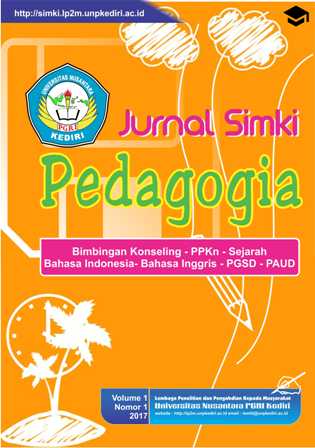THE EFFECT OF SHORT FILM TO THE STUDENTS\' SPEAKING ABILITY AT THE TENTH GRADE OF SMK TI PELITA NUSANTARA KEDIRI IN THE ACADEMIC YEAR 2018/2019
Author (Penulis)
LAILATUL KHAFIFAHUniversitas Nusantara PGRI Kediri
Author Identity (NPM)
14.1.01.08.0088Abstract
Speaking becomes one of the skills which is important to be learnt, it is a way to communicate with other people. In fact, there are many students get difficulties in speaking. They are poor in grammar and pronunciation, and they do lack of practice in their speaking English. The students also are not that confident to speak and unmotivated. Film is the solution to improve students’ speaking ability, especially short film. This research aims to explain about how is the students’ speaking ability before and after being taught using short film, and the effect of short film to the students’ speaking ability at the tenth grade of SMKTI Pelita Nusantara Kediri in academic year 2018/2019.This research uses pre-experimental quantitative research with one group of pre-test and post-test design. The population of this research was 55 students at 3 programs at SMKTI Pelita Nusantara Kediri in academic year 2018/2019. The sample of this research was 15 students consist of 13 males and 2 females of RPL class. The speaking test was used to collect the data. The data analyzed using paired sample t-test of IMB SPSS Statistic version 23. The result showed that the mean score of pre-test was 55 and post-test was 75 with the t-score was 11.502. Therefore this study showed that short film has significant effect to the students’ speaking ability of SMKTI Pelita Nusantara Kediri. it helps students’ with their speaking aspect. From the result above, it is suggested that short film can be used as an alternative media in teaching speaking and improve students speaking ability, especially in speaking aspect such as pronunciation, fluency, grammar, and vocabulary.
Keyword
aReference
Amalia,Lydia.(2017). Teaching Vocabulary Through Movie to Improve Vocabulary Mastery of the First Grade Students at SMPN 26 Bandar Lampung. A Thesis. Lampung: Faculty of Teacher Training and Education University of Lampung.
Arends, Richard. (2008). Learning to Teach.Jogjakarta: Pustaka Pelajar
Brown, H. D. 2004. Language Assessment: Principles and Classroom Practices. New York: Pearson Education, Inc.
Cameron, Lynne.(2001). Teaching Languages to Young Learners. Cambridge: Cambridge University Press.
Gelfgren, Stefan. (2012) Digital Religion, Social Media and Culture. Peter Lang Inc. International Academic Publisher
Ismaili, Merita. MA. (2013) The Effectiveness of Using Movies in the EFL Classroom – A Study Conducted at South East European University. Academic Journal of Interdisciplinary Studies. MCSER-CEMAS-Sapieza University of Rome
Maley, A. (2001). Film.Oxford: Oxford University Press.
Mirvan. X. (2013). The advantages of using films to enhance student’s reading skills in the EFL classroom. Journal of Education and Practice, 13(4), 62-67.
Putra, I.P.B. (2012). Learning vocabulary using English movies with subtitles in SMAK Santo Yoseph. English Educational Journal of Udayana University, p.1-8.
Sari, A., & Sugandi, B. (2015). Teaching English Through English Movie: Advantages and Disadvantages. Journal of English literacy education. Vol 2, No. 2, p.10-15
Ur, P. (1996). A course in language teaching.Cambridge: Cambridge University Press.
